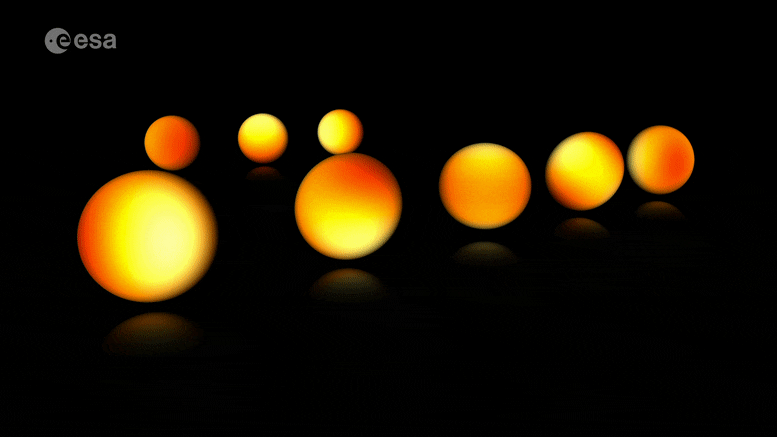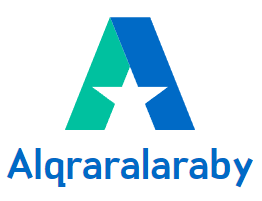
أحد الاكتشافات المفاجئة التي خرجت من إصدار بيانات Gaia 3 ، هو أن Gaia قادر على اكتشاف الزلازل النجمية – وهي حركات صغيرة على سطح نجم – التي تغير أشكال النجوم ، وهو أمر لم يُنشئ المرصد في الأصل من أجله. الائتمان: ESA / Gaia / DPAC ، CC BY-SA 3.0 IGO
Gaia هي مهمة وكالة الفضاء الأوروبية (ESA) لإنشاء خريطة دقيقة ثلاثية الأبعاد لأكثر من مليار نجم في جميع أنحاء[{” attribute=””>Milky Way galaxy and beyond. Although it launched all the way back in 2013, it is still working to accurately map the the motions, luminosity, temperature and composition of the stars in our galaxy.
Along the way it has made numerous discoveries, such as detecting a shake in the Milky Way, the observation of almost 500 explosions in galaxy cores, crystallization in white dwarfs, and discovering a billion-year-old river of stars. It also revealed the total weight of the Milky Way, a direct measurement of the galactic bar in the Milky Way, mysterious fossil spiral arms in the Milky Way, and a new member of the Milky Way family.
Today marks the data of the third data release from Gaia. The first data release was on September 14, 2016, followed by the second data release on April 25, 2018. On December 3, 2020, they did an early third data release with detailed data on more than 1.8 billion stars. All this data is helping to reveal the origin, structure, and evolutionary history of our galaxy.

This image shows four sky maps made with the new ESA Gaia data released on June 13, 2022. Credit: © ESA/Gaia/DPAC; CC BY-SA 3.0 IGO
Today (June 13, 2022), ESA’s Gaia mission releases its new treasure trove of data about our home galaxy. Astronomers describe strange ‘starquakes’, stellar DNA, asymmetric motions, and other fascinating insights in this most detailed Milky Way survey to date.
Gaia is ESA’s mission to create the most accurate and complete multi-dimensional map of the Milky Way. This allows astronomers to reconstruct our home galaxy’s structure and past evolution over billions of years, and to better understand the lifecycle of stars and our place in the Universe.
https://www.youtube.com/watch؟v=rTMFSvFvk38
ما الجديد في إصدار البيانات 3؟
يحتوي إصدار بيانات Gaia 3 على تفاصيل جديدة ومحسنة لما يقرب من ملياري نجم في مجرتنا. يتضمن الكتالوج معلومات جديدة بما في ذلك التراكيب الكيميائيةودرجات الحرارة النجمية والألوان والكتل والأعمار والسرعة التي تتحرك بها النجوم نحونا أو بعيدًا عنا (السرعة الشعاعية). تم الكشف عن الكثير من هذه المعلومات من قبل المفرج عنهم حديثًا التحليل الطيفي البيانات ، وهي تقنية ينقسم فيها ضوء النجوم إلى الألوان المكونة له (مثل قوس قزح). تتضمن البيانات أيضًا مجموعات فرعية خاصة من النجوم ، مثل تلك التي تغير السطوع بمرور الوقت.
الجديد أيضًا في مجموعة البيانات هذه هو أكبر كتالوج حتى الآن للنجوم الثنائية ، وآلاف من كائنات النظام الشمسي مثل الكويكبات وأقمار الكواكب ، وملايين المجرات والكوازارات خارج مجرة درب التبانة.
https://www.youtube.com/watch؟v=8Dh-Po0UGyM
زلازل
من أكثر الاكتشافات إثارة للدهشة التي تمخضت عنها البيانات الجديدة أن Gaia قادر على اكتشاف الزلازل النجمية – وهي حركات صغيرة على سطح نجم – والتي تغير أشكال النجوم ، وهو أمر لم يُنشئ المرصد في الأصل من أجله.
في السابق ، وجد Gaia بالفعل اهتزازات شعاعية تتسبب في تضخم النجوم وتقلصها بشكل دوري ، مع الحفاظ على شكلها الكروي. لكن جايا رصدت الآن أيضًا اهتزازات أخرى تشبه إلى حد كبير تسونامي على نطاق واسع. تغير هذه التذبذبات غير الشعاعية الشكل العالمي للنجم وبالتالي يصعب اكتشافها.
وجد جايا زلازل قوية غير شعاعية في آلاف النجوم. كشف Gaia أيضًا عن مثل هذه الاهتزازات في النجوم التي نادرًا ما شوهدت من قبل. لا ينبغي أن تحتوي هذه النجوم على أي زلازل وفقًا للنظرية الحالية ، بينما اكتشفها جايا على سطحها.
“Starquakes تعلمنا الكثير عن النجوم ، لا سيما أعمالهم الداخلية. تفتتح جايا منجم ذهب لعلم النجوم الضخمة “، كما يقول كوني أيرتس من جامعة KU لوفين في بلجيكا ، وهو عضو في تعاون جايا.
https://www.youtube.com/watch؟v=uZbwzNwbu4Y
الحمض النووي للنجوم
يمكن أن تخبرنا المواد التي تتكون منها النجوم عن مكان ولادتها ورحلتها بعد ذلك ، وبالتالي عن تاريخ مجرة درب التبانة. مع إصدار البيانات اليوم ، تكشف Gaia عن أكبر خريطة كيميائية للمجرة مقترنة بحركات ثلاثية الأبعاد ، من جوارنا الشمسي إلى المجرات الأصغر المحيطة بنا.
تحتوي بعض النجوم على “معادن ثقيلة” أكثر من غيرها. أثناء ال[{” attribute=””>Big Bang, only light elements were formed (hydrogen and helium). All other heavier elements – called metals by astronomers – are built inside stars. When stars die, they release these metals into the gas and dust between the stars called the interstellar medium, out of which new stars form. Active star formation and death will lead to an environment that is richer in metals. Therefore, a star’s chemical composition is a bit like its DNA, giving us crucial information about its origin.

This image shows an artistic impression of the Milky Way, and on top of that an overlay showing the location and densities of a young star sample from Gaia’s data release 3 (in yellow-green). The “you are here” sign points towards the Sun. Credit: © ESA/Gaia/DPAC; CC BY-SA 3.0 IGO
With Gaia, we see that some stars in our galaxy are made of primordial material, while others like our Sun are made of matter enriched by previous generations of stars. Stars that are closer to the center and plane of our galaxy are richer in metals than stars at larger distances. Gaia also identified stars that originally came from different galaxies than our own, based on their chemical composition.
“Our galaxy is a beautiful melting pot of stars,” says Alejandra Recio-Blanco of the Observatoire de la Côte d’Azur in France, who is a member of the Gaia collaboration.
“This diversity is extremely important, because it tells us the story of our galaxy’s formation. It reveals the processes of migration within our galaxy and accretion from external galaxies. It also clearly shows that our Sun, and we, all belong to an ever-changing system, formed thanks to the assembly of stars and gas of different origins.”

This image shows the orbits of the more than 150,000 asteroids in Gaia’s data release 3, from the inner parts of the Solar System to the Trojan asteroids at the distance of Jupiter, with different color codes. The yellow circle at the center represents the Sun. Blue represents the inner part of the Solar System, where the Near Earth Asteroids, Mars crossers, and terrestrial planets are. The Main Belt, between Mars and Jupiter, is green. Jupiter trojans are red. Credit: © ESA/Gaia/DPAC; CC BY-SA 3.0 IGO, Acknowledgements: P. Tanga (Observatoire de la Côte d’Azur)
Binary stars, asteroids, quasars, and more
Other papers that are published today reflect the breadth and depth of Gaia’s discovery potential. A new binary star catalog presents the mass and evolution of more than 800 thousand binary systems, while a new asteroid survey comprising 156 thousand rocky bodies is digging deeper into the origin of our Solar System. Gaia is also revealing information about 10 million variable stars, mysterious macro-molecules between stars, as well as quasars and galaxies beyond our own cosmic neighborhood.

The position of each asteroid at 12:00 CEST on June 13, 2022, is plotted. Each asteroid is a segment representing its motion over 10 days. Inner bodies move faster around the Sun (yellow circle at the center). Blue represents the inner part of the Solar System, where the Near Earth Asteroids, Mars crossers, and terrestrial planets are. The Main Belt, between Mars and Jupiter, is green. The two orange ‘clouds’ correspond to the Trojan asteroids of Jupiter. Credit: © ESA/Gaia/DPAC; CC BY-SA 3.0 IGO, Acknowledgements: P. Tanga (Observatoire de la Côte d’Azur)
“Unlike other missions that target specific objects, Gaia is a survey mission. This means that while surveying the entire sky with billions of stars multiple times, Gaia is bound to make discoveries that other more dedicated missions would miss. This is one of its strengths, and we can’t wait for the astronomy community to dive into our new data to find out even more about our galaxy and its surroundings than we could’ve imagined,” says Timo Prusti, Project Scientist for Gaia at ESA.

“متعطش للطعام. طالب. متحمس محترف للزومبي. مبشر شغوف بالإنترنت.”




More Stories
مهمة ستارلينك الثلاثاء من كيب كانافيرال
زخات نيزك Lyrid تبلغ ذروتها. كيف ترى الليلة في ولاية ايوا
اكتشف العلماء مفتاحًا لكشف سر اضطرابات الدماغ التنكسية مثل مرض الزهايمر